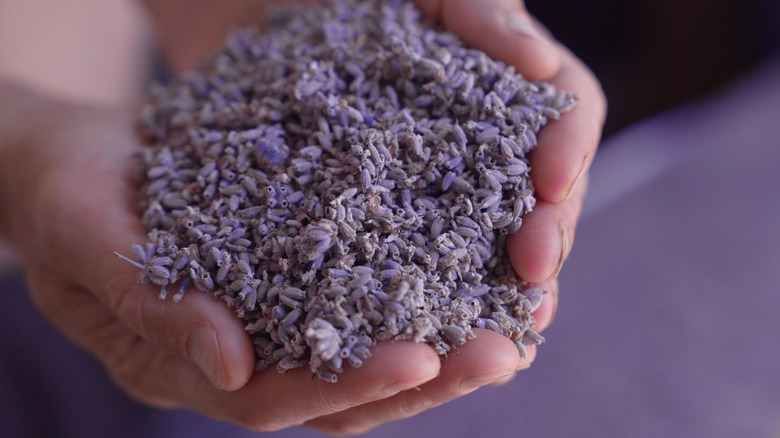The Best Lavender Variety To Plant If You Want To Cook With It
We may receive a commission on purchases made from links.
While lavender is perhaps best known for its use in essential oils and as a beautiful addition to front yards, cooking with the aromatic, soft purple herb might very well leave you in a pleasant lavender haze. While all lavender varieties (and there are a lot since there are over 40 species of the plant) are said to be edible, not all are created equally for cooking. If you want to cook with it, the best lavenders to plant in your garden are varieties of English lavender, such as Buena Vista and Folgate.
These lavender cultivars belong to the Lavandula angustifolia species (true lavender) as opposed to lavandin hybrids (Lavandula x intermedia), which aren't great for cooking due to their pungent camphor-like taste and strong woody aroma. Instead, English lavender cultivars are known for their balanced, soothingly-sweet floral taste and aroma when used in culinary applications.
English lavender, which grows perennially in cooler climates with full sun, low water, and rocky, well-drained soil, is the best to grow in your garden if you plan to cook with it. Although, you could also cook with French lavender, which is typically more fragrant and even has hints of rosemary aromatics. However, the balanced sweetness of English lavender is ideal for a variety of creative ways to use lavender in cooking, from making buttery shortbread cookies to bright and floral summer salads.
How to harvest and cook with lavender
Lavender is relatively easy to grow and introduce into your herb garden, so don't sweat it if you don't have a particularly green thumb. It helps if you place lavender in a sunny area in the right climate and conditions based on the variety. For instance, English lavender grows and blooms well in late spring and mid-summer and some cultivars can weather colder conditions, while Spanish lavender (which is considered more decorative than culinary, though it is edible) flourishes best in warmer environments.
When harvesting lavender from your garden for culinary use, it's crucial to "clean" the herb by sifting it several times to remove the bitter stems and leaves. For a floral fragrance and taste in cooking, all you want is the buds of the plant. Once you've harvested and dried it, you can easily chop culinary cultivars like English lavender and use it to add a botanical lightness to rich ingredients and dishes like restaurant-quality whipped butter or cream sauce, or to make lavender honey ice cream.
Lavender's aromatics work brilliantly with tart citrus, so try adding it to a lemonade (like this springtime lavender lemonade) or a bright and sunny lemon lavender cake. You can also craft a lavender simple syrup to add to a variety of cocktails and other drinks. For instance, you can make a barista-worthy lavender latte by infusing lavender in your dairy or plant-based milk of choice. It's the perfect flavor accent for spring, or any time of year, really. You can order a packet of English lavender seeds from NatureZ Edge on Amazon to get started.

